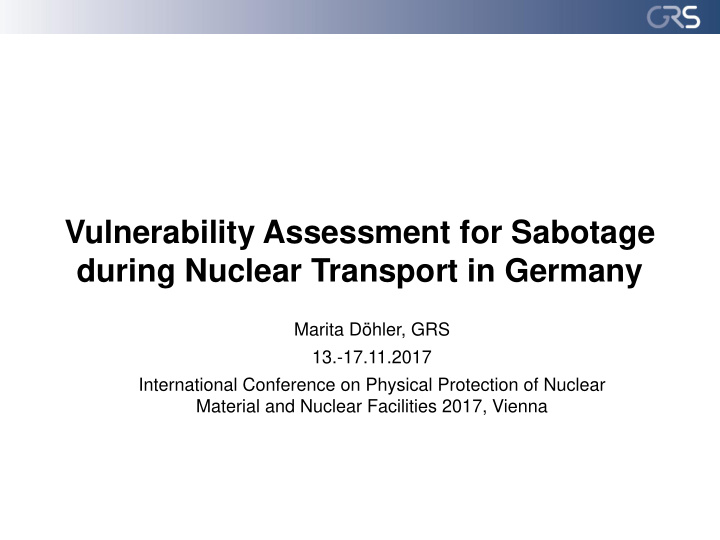



Vulnerability Assessment for Sabotage during Nuclear Transport in Germany Marita Döhler, GRS 13.-17.11.2017 International Conference on Physical Protection of Nuclear Material and Nuclear Facilities 2017, Vienna
Contents Motivation: Vulnerability Assessment for Sabotage during Nuclear Transport in Germany Assessment of Potential Consequences of Sabotage during Nuclear Transport Challenges Summary 2
Motivation Nuclear Security Series No. 13, Nuclear Security Recommendations on Physical Protection of Nuclear Material and Nuclear Facilities: Radioactive material has to be protected against unauthorized removal since it could have significant consequences if dispersed or used otherwise for a malicious act …the State should define protection requirements that correspond to the level of potential radiological consequences. 3
Motivation Nuclear Security Series No. 26-G, Implementing Guide, Security of Nuclear Material in Transport: 4
Motivation Revision of german DBT for Nuclear Material Transports DBT (Confidential) -> major effects with respect to sabotage (Guideline Guideline Guideline Guideline „Air“) „Road & Rail “ „ Sea “ „ Personnel “ Restricted Latest revision of associated guidelines (drafts) Requirements and measures -> new categorization scheme 5
Motivation Sabotage leads to unaccaptable radiological consequences: „Sabotage -relevant (FS)“ Results in six Categories: Cat. I Cat. II Cat. III Cat. I FS Cat. II FS Cat. III FS 6
Motivation Nuclear Material Transport categorized as Cat I FS Cat II FS Cat III FS -> additional requirements: - prevent unacceptable consequences - … 7
Motivation Within licensing process… … the applicant has to ( i. a.) - categorize the Nuclear Material Transport, - to prove that there are no unacceptable radiological consequences as a result of a sabotage … the Competent Authority proves with the help of third party experts whether the requirements are fulfilled For Categorization and for proving effectiveness of additional measures: Assessing radiological consequences 8
Assessment of Potential Consequences of Sabotage during Nuclear Transport First step: Categorization regarding Sabotage Sabotage affects cask No additional structures are considered No measures Assessment: Damage Pattern of: • Cask • Inventory Airborne Release Fraction (ARF) of inventory (respirable aerosols) Aerosol transport process from the inside of the cask to the environment 9
Assessment of Potential Consequences of Sabotage during Nuclear Transport Second step: Determination of dispersion of respirable particles Dose calculation 10
Assessment of Potential Consequences of Sabotage during Nuclear Transport Definition of boundary conditions: - What are unacceptable radiological consequences? - Dose for one person or a group? - Distance? - Locations? - Exposure for which period? - Velocity of wind? - Rain? … - 11
Assessment of Potential Consequences of Sabotage during Nuclear Transport If the Nuclear Material Transport is categorized as „sabotage - relevant“ (FS) additional measures have to be added. One requirement: Unacceptable radiological consequences have to be prevented. Assessment starts again taking into account all measures 12
Challenges Two main questions: What could be suitable measures? How can the effectiveness of the systems be proved? 13
Challenges What could be suitable measures? Add as much material around the cask that no sabotage act leads to any radiological consequences • Passive measure • Heavy • Large-sized • Heat removal • … Add less material around the cask to mitigate the damage of cask and inventory and with this the release of particles • Passive measure • Maybe heavy • Maybe large-sized • Sufficiency • … 14
Challenges What could be suitable measures? Add active systems like sprinkling systems/foams to wash out particles Active system Need of triggering Efficiency … 15
Challenges How can the effectiveness of the systems be proved? Performing experiments Numerical simulations Inspections of implemented measures 16
Summary Revision of german DBT for Nuclear Material Transports: Major effects with respect to sabotage Revision of guideline (draft): New categorization regarding sabotage followed by new requirements Precise assessment of radiological consequences needed Challenges resulting from the new regulations (suitable measures, prove efficiency) 17
Thanks for your attention! 18
Recommend
More recommend